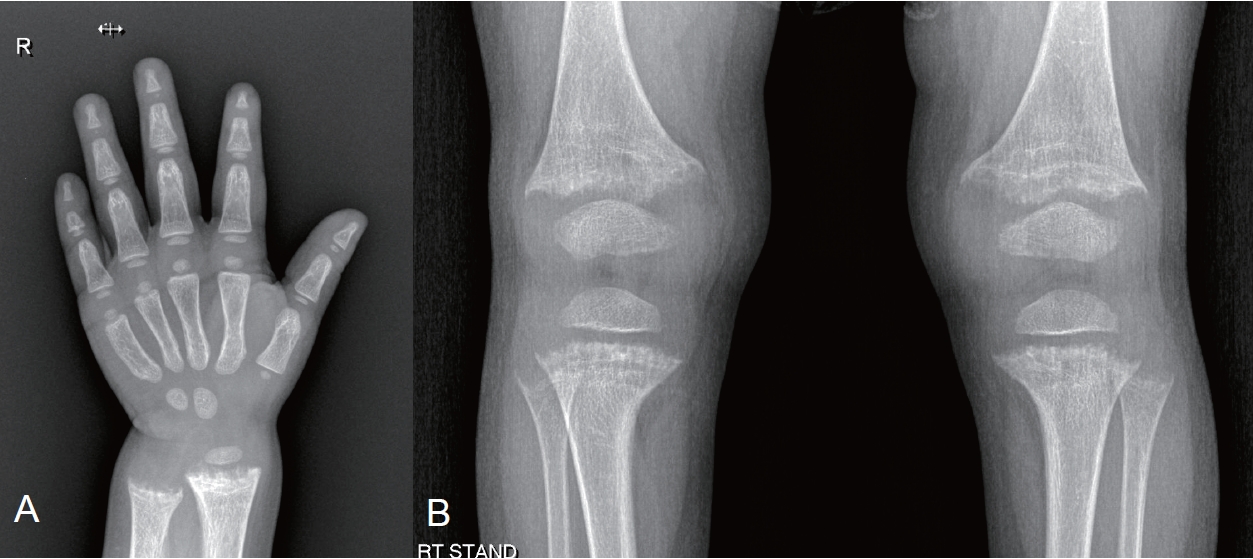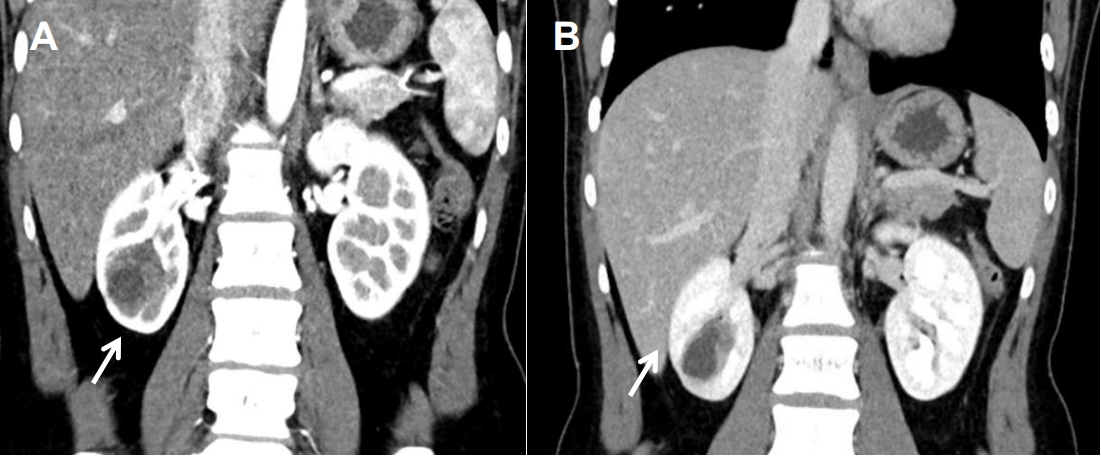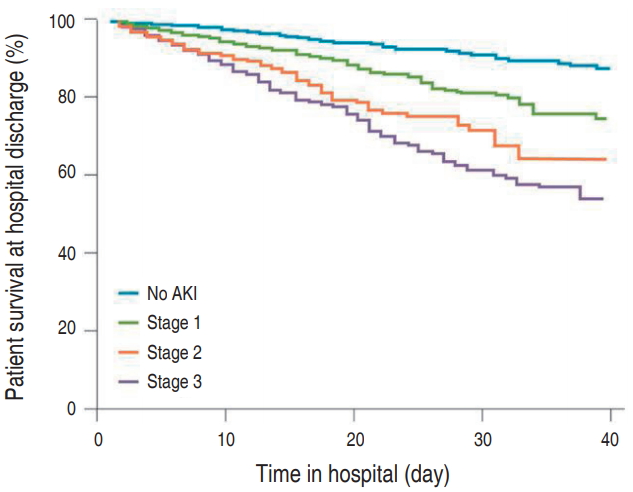Search
- Page Path
-
- HOME
- Search
- Review Article
- Nephrology (Genitourinary)
- X-linked hypophosphatemic rickets: from diagnosis to management
- Eujin Park, Hee Gyung Kang
- Clin Exp Pediatr. 2024;67(1):17-25. Published online June 14, 2023
-

· X-linked hypophosphatemia (XLH), the most common cause of hypophosphatemic rickets, affects 1/20,000 people.
· XLH is caused by a loss-of-function mutation of the PHEX gene.
· Its main pathogenesis is elevated fibroblast growth factor-23 (FGF23) level.
· Burosumab, an FGF23 inhibitor, was developed in the early 2000s.
· Burosumab was approved in Korea in 2020 for XLH patients aged 1+ years with radiographic evidence of bone disease.
- Case Report
- Reninoma: a rare cause of curable hypertension
- Ji Hye Kim, Ji Hyun Kim, Myung Hyun Cho, Eujin Park, Hye Sun Hyun, Yo Han Ahn, Hee Gyung Kang, Kyung Chul Moon, Il-Soo Ha, Hae Il Cheong
- Clin Exp Pediatr. 2019;62(4):144-147. Published online October 29, 2018
-

The most common type of refractory hypertension found in children is secondary hypertension, which is a potentially curable disease. Reninoma, a renin-secreting juxtaglomerular cell tumor, is a rare cause of severe hypertension that is usually diagnosed in adolescents and young adults. Surgical resection of the tumor completely cures the hypertension of patients with reninoma. The typical clinical presentation of reninoma...
- Review Article
- Nephrology (Genitourinary)
- Acute kidney injury and continuous renal replacement therapy in children; what pediatricians need to know
- Myung Hyun Cho, Hee Gyung Kang
- Clin Exp Pediatr. 2018;61(11):339-347. Published online October 23, 2018
-

Acute kidney injury (AKI) is characterized by abrupt deterioration of renal function, and its diagnosis relies on creatinine measurements and urine output. AKI is associated with higher morbidity and mortality, and is a risk factor for development of chronic kidney disease. There is no proven medication for AKI. Therefore, prevention and early detection are important. Physicians should be aware of...
- Original Article
- Oncology
- Posttransplantation lymphoproliferative disorder after pediatric solid organ transplantation: experiences of 20 years in a single center
- Hyung Joo Jeong, Yo Han Ahn, Eujin Park, Youngrok Choi, Nam-Joon Yi, Jae Sung Ko, Sang Il Min, Jong Won Ha, Il-Soo Ha, Hae Il Cheong, Hee Gyung Kang
- Clin Exp Pediatr. 2017;60(3):86-93. Published online March 27, 2017
-

Purpose To evaluate the clinical spectrum of posttransplantation lymphoproliferative disorder (PTLD) after solid organ transplantation (SOT) in children.
Methods We retrospectively reviewed the medical records of 18 patients with PTLD who underwent liver (LT) or kidney transplantation (KT) between January 1995 and December 2014 in Seoul National University Children's Hospital.
Results Eighteen patients (3.9% of pediatric SOTs; LT:KT, 11:7; male to female, 9:9) were diagnosed...
- Case Report
- Immunology
- A familial case of Blau syndrome caused by a novel
NOD2 genetic mutation - Woojoong Kim, Eujin Park, Yo Han Ahn, Jiwon M. Lee, Hee Gyung Kang, Byung Joo Kim, Il-Soo Ha, Hae Il Cheong
- Clin Exp Pediatr. 2016;59(Suppl 1):S5-S9. Published online November 30, 2016
-
Blau syndrome (BS) is a rare autosomal dominant, inflammatory syndrome that is characterized by the clinical triad of granulomatous dermatitis, symmetric arthritis, and recurrent uveitis. Mutations in the nucleotide oligomerization domain 2 (
NOD2 ) gene are responsible for causing BS. To date, up to 30 Blau-associated genetic mutations have been identified within this gene. We report a novelNOD2 genetic mutation...
- Genetics and Metabolism
- A nonsense
PAX6 mutation in a family with congenital aniridia - Kyoung Hee Han, Hye Jin Lee, Il-Soo Ha, Hee Gyung Kang, Hae Il Cheong
- Clin Exp Pediatr. 2016;59(Suppl 1):S1-S4. Published online November 30, 2016
-
Congenital aniridia is a rare ocular malformation that presents with severe hypoplasia of the iris and various ocular manifestations. Most cases of congenital aniridia are known to be related to mutations in the paired box gene-6 (
PAX6 ), which is an essential gene in eye development. Herein, we report a familial case of autosomal dominant congenital aniridia with four affected members...
- Nephrology (Genitourinary)
- Bilateral iliac and popliteal arterial thrombosis in a child with focal segmental glomerulosclerosis
- Kyoung Hee Han, Ji Youn Park, Seung-Kee Min, Il-Soo Ha, Hae Il Cheong, Hee Gyung Kang
- Clin Exp Pediatr. 2016;59(5):242-245. Published online May 31, 2016
-
Thromboembolic complications (TECs) are clinically important sequelae of nephrotic syndrome (NS). The incidence of TECs in children is approximately 2%–5%. The veins are the most commonly affected sites, particularly the deep veins in the legs, the inferior vena cava, the superior vena cava, and the renal veins. Arterial thrombosis, which is less common, typically occurs in the cerebral, pulmonary, and...
- Review Article
- Nephrotic syndrome: what's new, what's hot?
- Hee Gyung Kang, Hae Il Cheong
- Clin Exp Pediatr. 2015;58(8):275-282. Published online August 21, 2015
-
While the incidence of nephrotic syndrome (NS) is decreasing in Korea, the morbidity of difficult-to-treat NS is significant. Efforts to minimize treatment toxicity showed that prolonged treatment after an initial treatment for 2-3 months with glucocorticosteroids was not effective in reducing frequent relapses. For steroid-dependent NS, rituximab, a monoclonal antibody against the CD20 antigen on B cells, was proven to...
- Original Article
- Initial steroid regimen in idiopathic nephrotic syndrome can be shortened based on duration to first remission
- Hee Sun Baek, Ki-Soo Park, Hee Gyung Kang, Cheol Woo Ko, Min Hyun Cho
- Clin Exp Pediatr. 2015;58(6):206-210. Published online June 22, 2015
-
Purpose The use of a 12-week steroid regimen (long-term therapy, LT) for the first episode of idiopathic nephrotic syndrome (NS) reportedly induces a more sustained remission and lower relapse rate than previous regimens, including an 8-week steroid regimen (short-term therapy, ST). Here, we assessed the potential for selective application of 2 steroid regimens (LT vs. ST) based on the days to...
- Outcomes of chronic dialysis in Korean children with respect to survival rates and causes of death
- Hye Jin Chang, Kyoung Hee Han, Min Hyun Cho, Young Seo Park, Hee Gyung Kang, Hae Il Cheong, Il Soo Ha
- Clin Exp Pediatr. 2014;57(3):135-139. Published online March 31, 2014
-
Purpose Adult Korean patients on chronic dialysis have a 9-year survival rate of 50%, with cardiovascular problems being the most significant cause of death. The 2011 annual report of the North American Pediatric Renal Trials and Collaborative Studies group reported 3-year survival rates of 93.4% and relatively poorer survival in younger patients.
Methods In this study, we have reviewed data from Korean Pediatric...
- Case Report
- Shiga toxin-associated hemolytic uremic syndrome complicated by intestinal perforation in a child with typical hemolytic uremic syndrome
- Hye Jin Chang, Hwa Young Kim, Jae Hong Choi, Hyun Jin Choi, Jae Sung Ko, Il Soo Ha, Hae Il Cheong, Yong Choi, Hee Gyung Kang
- Clin Exp Pediatr. 2014;57(2):96-99. Published online February 24, 2014
-
Hemolytic uremic syndrome (HUS) is one of the most common causes of acute renal failure in childhood and is primarily diagnosed in up to 4.5% of children who undergo chronic renal replacement therapy.
Escherichia coli serotype O157:H7 is the predominant bacterial strain identified in patients with HUS; more than 100 types of Shiga toxin-producing enterohemorrhagicE. coli (EHEC) subtypes have...
- Original Article
- Intravenous fluid prescription practices among pediatric residents in Korea
- Jiwon M. Lee, Younghwa Jung, Se Eun Lee, Jun Ho Lee, Kee Hyuck Kim, Ja Wook Koo, Young Seo Park, Hae Il Cheong, Il-Soo Ha, Yong Choi, Hee Gyung Kang
- Clin Exp Pediatr. 2013;56(7):282-285. Published online July 19, 2013
-
Purpose Recent studies have established the association between hypotonic fluids administration and hospital-acquired hyponatremia in children. The present paper investigated the pattern of current practice in intravenous fluid prescription among Korean pediatric residents, to underscore the need for updated education.
Methods A survey-based analysis was carried out. Pediatric residents at six university hospitals in Korea completed a survey consisting of four questions. Each...
- Review Article
- Treatment of steroid-resistant pediatric nephrotic syndrome
- Hee Gyung Kang
- Clin Exp Pediatr. 2011;54(8):317-321. Published online August 31, 2011
-
Children who suffer from steroid-resistant nephrotic syndrome (SRNS) require aggressive treatment to achieve remission. When intravenous high-dose methylprednisolone fails, calcineurin inhibitors, such as cyclosporine and tacrolimus, are used as the first line of treatment. A significant number of patients with SRNS progress to end-stage renal disease if remission is not achieved. For these children, renal replacement therapy can also be...
- Case Report
- A case of pseudohypoaldosteronism type 1 with a mutation in the mineralocorticoid receptor gene
- Se Eun Lee, Yun Hye Jung, Kyoung Hee Han, Hyun Kyung Lee, Hee Gyung Kang, Il Soo Ha, Yong Choi, Hae Il Cheong
- Clin Exp Pediatr. 2011;54(2):90-93. Published online February 28, 2011
-
Pseudohypoaldosteronism type 1 (PHA1) is a rare form of mineralocorticoid resistance characterized in newborns by salt wasting with dehydration, hyperkalemia and failure to thrive. This disease is heterogeneous in etiology and includes autosomal dominant PHA1 owing to mutations of the
NR3C2 gene encoding the mineralocorticoid receptor, autosomal recessive PHA1 due to mutations of the epithelial sodium channel (ENaC ) gene, and...
- Renal transplantation in a patient with Bartter syndrome and glomerulosclerosis
- Se Eun Lee, Kyoung Hee Han, Yun Hye Jung, Hyun Kyung Lee, Hee Gyung Kang, Kyung Chul Moon, Il Soo Ha, Yong Choi, Hae Il Cheong
- Clin Exp Pediatr. 2011;54(1):36-39. Published online January 31, 2011
-
Bartter syndrome (BS) is a clinically and genetically heterogeneous inherited renal tube disorder characterized by renal salt wasting, hypokalemic metabolic alkalosis and normotensive hyperreninemic hyperaldosteronism. There have been several case reports of BS complicated by focal segmental glomerulosclerosis (FSGS). Here, we have reported the case of a BS patient who developed FSGS and subsequent end-stage renal disease (ESRD) and provided...
- A case of Bartter syndrome type I with atypical presentations
- Eun Hye Lee, Ju Sun Heo, Hyun Kyung Lee, Kyung Hee Han, Hee Gyung Kang, Il Soo Ha, Yong Choi, Hae Il Cheong
- Clin Exp Pediatr. 2010;53(8):809-813. Published online August 31, 2010
-
Bartter syndrome (BS) is an autosomal recessively inherited rare renal tubular disorder characterized by hypokalemic metabolic alkalosis and hyperreninemic hyperaldosteronism with normal to low blood pressure due to a renal loss of sodium. Genetically, BS is classified into 5 subtypes according to the underlying genetic defects, and BS is clinically categorized into antenatal BS and classical BS according to onset...
- Original Article
- Urinary Tract Infections in Febrile Infants under Three Months of Age
- Byung Wook Eun, Yoo Mi Chung, Hee Gyung Kang, Il Soo Ha, Hae Il Cheong, Hoan Jong Lee, Yong Choi
- Clin Exp Pediatr. 2003;46(3):265-270. Published online March 15, 2003
-
Purpose : To characterize the infants under 3 months of age with urinary tract infections(UTIs), and especially patients with bacteremia or meningitis Methods : Hospital records of all the infants under 3 months of age discharged from our hospital for 69 consecutive months with the diagnosis of initial episode of UTI were reviewed. UTI was defined when patients had fever with... -
- Case Report
- A Case of Systemic Capillary Leak Syndrome in a Child
- Taeg Young Lee, Yoo Mi Chung, Hee Gyung Kang, Il Soo Ha, Hae Il Cheong, Yong Choi
- Clin Exp Pediatr. 2002;45(10):1292-1297. Published online October 15, 2002
-
Systemic capillary leak syndrome(SCLS) is a rare disorder of unknown etiology, which is characterized by recurrent attacks of hypotension, hemoconcentration, and hypoalbuminemia. Urinary or enteric loss of protein is not demonstrated. It is often associated with monoclonal gammopathy, but does not manifest multiple myeloma. Since Clarkson et al. described the first case in a 34- year-old woman, about 50 cases have been reported in... -
-

-
-

-

-
Impact Factor4.2
-
6.52022CiteScore92nd percentilePowered by







